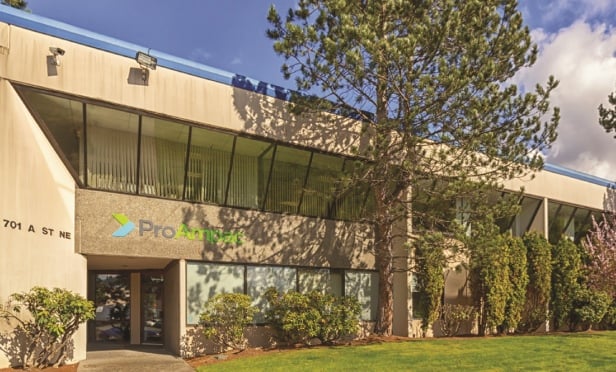SANTA ANA, CA-Grubb & Ellis has been an active investor in all sectors of the commercial real estate industry through its real estate investment and asset management subsidiary, Grubb & Ellis Equity Advisors, with a portfolio of nearly $6 billion in office, industrial, retail, multifamily and healthcare-related properties throughout 32 states. The investment subsidiary's main focus lately, however, has been on the healthcare sector, where its Grubb & Ellis Healthcare REIT II has acquired approximately $170 million worth of assets in the past two quarters. The non-traded REIT plans to sell up to nearly $3.3 billion in stock over the course of its offering, according to its prospectus. The executive overseeing both REIT II and Grubb & Ellis Equity Advisors is Jeff Hanson, who is CEO of both. Hanson recently talked about why the company is focusing its investment efforts on the healthcare sector and why it believes that a non-traded REIT is a good vehicle for such investment.
GlobeSt.com: You have described Grubb & Ellis Healthcare REIT II as your flagship product. How does it fit into your overall investment strategy at Grubb & Ellis Equity Advisors?
Hanson: Obviously, we have a very large portfolio with our roughly $6 billion of investment across all major product sectors. The foremost reason for our focus on healthcare is that we identified it as the preeminent example of a real estate sector that has built-in demand drivers that fundamentally don't exist in other product sectors. It is driven by demographic trends that are going to shape the nation over not just the next few years as a fleeting trend, but over the next several decades.
GlobeSt.com: What is it that you like about the non-traded REIT platform as an investment vehicle for healthcare-related assets?
Hanson: We have a group of 150 broker-dealers across the country with which we have selling agreements, but the common denominator with all of them is retail investors. Retail investors want safety and predictability, and that is what you can deliver with an underlying vehicle that is investing in healthcare-related real estate. These are predominantly Baby-Boomers who are looking for a current-pay, fixed-income type product that is safe. They're interested in getting a respectable return on their money, without a lot of risk, over the long term. Their desire for stability fits very well with the nature of a non-traded REIT, which is a long-term hold strategy. For Grubb & Ellis Healthcare REIT II, we model on a 10-year hold.
GlobeSt.com: How has REIT II fared in raising equity?
Hanson: We began raising equity about a year ago and have raised $150 million so far. Non-traded REITS raised about $6.1 billion last year (2009) and are expected to raise about $8 billion this year (2010). Although there is a lot of trepidation about real estate investing, this is a sector that is going to be up 33% year-over-year in terms of equity raised.
GlobeSt.com: Who are the sellers in the healthcare sector and why are they selling?
Hanson: There are a lot of private sellers across all the categories within the sector. There are also hospitals that are looking to monetize their assets. Hospitals recognize that their return on invested capital is probably higher by investing in their core business than it is even in a good real estate climate. One reason that a lot of the sellers are private is that healthcare is one of the mainstream product types where there is not a lot of institutional ownership. For the other product sectors, there is an average of 18% to 25% institutional ownership across the sectors nationally, but it's only 5% to 7% in healthcare, so we saw an opportunity to come in as an institutional player and aggregate assets quickly to drive economies of scale across a broad portfolio.
GlobeSt.com: What segments are you focusing on within the overall healthcare sector?
Hanson: Our strategy is to invest 35% to 50% in on-campus medical office and the remaining in the other categories, such as skilled nursing, assisted living and hospitals.
GlobeSt.com: How large do you expect to build your portfolio over the course of your equity-raise?
Hanson: Our prospectus says that we plan a $3 billion best-efforts equity raise over three years. Leveraged at about 50%, that will translate to $5 billion to $6 billion of asset value.
GlobeSt.com: What cap rates are these assets trading at?
Hanson: Cap rates are in the high seven to low eight range for good quality campus medical office. Assisted living wants low to mid-eight, and skilled nursing mid-eight to low nine. Hospitals are anywhere from high eights to nines.
GlobeSt.com: Will these cap rates come down as healthcare-related properties grow even more popular with investors―and as the economy recovers?
Hanson: Because of the built-in demand drivers that exist in healthcare real estate and not elsewhere, cap rates have come down already. The peak in terms of the best buying opportunity, in terms of the highest cap rates for MOBs, was in 2009. The cap rates have trended down by about 25 basis points since then, but we're still in an environment where we have a phenomenal buying opportunity, and that will persist for a while. Even with the cap rates having trended down, the investment is still very accretive to a REIT that is paying a 6.5% dividend.
GlobeSt.com: One of the demand drivers you mention is the Baby-Boom generation, which demographers have been talking about for years. What is its impact?
Hanson: Between now and 2030, we will have two full decades of near-vertical aging of our population. What really speaks to the risk aversion that retail investors have is that, in the heart of the recession in 2008-2009, the country lost more than eight million jobs, but over that time healthcare added 720,000 net new jobs. That speaks volumes. It's real estate, but it's a very different type of real estate with built-in demand drivers. We have a chart that shows rent growth across the five major product types annually from 1992 to 2009. The chart shows rent spikes for all other sectors except healthcare, which shows an average of 2% to 2.5% growth consistently, almost in a straight line, and that was before the Baby-Boomers really started to come of age.
GlobeSt.com: What does all of this mean in terms of the investment outlook for healthcare properties?
Hanson: The timing couldn't be better. I believe firmly that the non-traded REITs launched by brand-name sponsors, with no legacy asset issues, will look back after the recovery and see in retrospect that they were some of the most successful non-traded REITs in the history of the sector. Because of the dislocation that exists in the market today, cash-rich vehicles that are able to buy on a broad scale with low leverage are in the driver's seat in today's acquisition environment.
© Touchpoint Markets, All Rights Reserved. Request academic re-use from www.copyright.com. All other uses, submit a request to [email protected]. For more inforrmation visit Asset & Logo Licensing.






